A treat for aficionados of Gujarati food
As a little girl, Parul Bhatt would watch in fascination, squatting on the floor, as her grandmother turned out delicious, aromatic, vegetarian food for the family, on her modest stove placed on the floor. As the various ingredients came to life under her expert hands, the little girl developed a passion for cooking, which only grew with the passing years. “Just like my grandma, my mother, and also my foiba (paternal aunt) were great cooks, and I learnt so much from them,” she says.
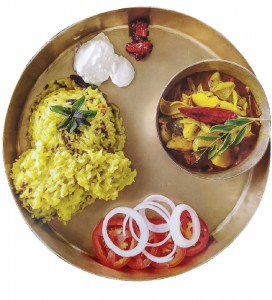
Her love for cooking transformed into her marketing pickles, papads and podis and other savouries as her friends encouraged her to share with a larger group her expertise in cooking.
But the elegantly produced coffee table book — Parul’s Magic: Everyday delicious easy to cook Gujarati dishes — really took shape “when I was in the US in 2014, to be with my elder daughter, during her delivery,” she smiles. The newly anointed mama and her younger sister back in Chennai, then 22, both loved their mother’s cooking. “Every night, when I chatted with my younger daughter, she would complain that she doesn’t like the food prepared by the cook. She was longing for my food. So I would compose on my iPad a simple recipe that she could prepare and then send it to her. She would try it out, share it with her colleagues at lunch in office and report back that they all loved the result,” smiles Parul.
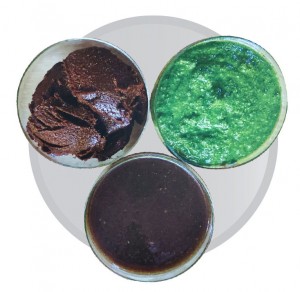
By the time she returned home from the US, she had a neat pile of about 40 recipes on her iPad. Of course they were all traditional Gujarati, vegetarian recipes, and the idea took root in her head that she should come out with a recipe book.
“But I had no idea how to go about writing a recipe book, or for that matter, writing anything at all.” But while helping her husband Satyan Bhatt, a Rotarian, in the family run PR business, and working closely with the late S Muthiah, a historian and passionate chronicler of Madras, on Madras Day, she once told the latter about her dream to publish a recipe book. “After that, he would constantly ask me about the progress I had made with this book. When I told him that frankly I had no idea how to go about bringing out such a book, he put me in touch with Chandra Padmanabhan (with experience in writing and publishing).”
Kansar Bhakshan is the first meal together for a couple immediately after the marriage. The bride’s mother brings Kansar on a plate and the couple feed each other to symbolise their union.
This was in 2016 and by now Parul’s recipe bag had 60 interesting Gujarati recipes. Chandra gave her one entire week and “over lengthy sessions in seven days, gave me a very good idea and constructive suggestions on what and how I should do the book. She said just saying ‘add salt or water’ is not enough… specify ¼ teaspoon of salt, two cups of water, etc. Be specific. Because everybody is not an expert like you. She taught me the importance of measurements and said: ‘Go back to your kitchen, make the dishes, measure how much spices or water, oil or ghee you put into the dish and then write the recipe. She literally hand-held me through how a book like this should be done.”
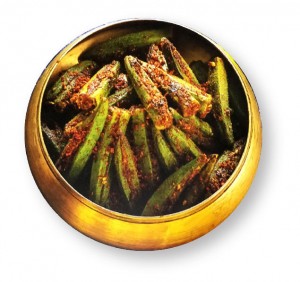
Parul took her advice seriously, went back to the drawing room — in this case her kitchen — and rewrote everything. Finally, the book took both shape and structure and the result is this fascinating book which has 142 recipes, which promise you Parul’s ‘magic’.
Take for instance bajra vada; the very name tells you that it will be healthy as the basic ingredient is a millet and not maida or wheat flour. “Today, not many people make it, even in Gujarat, but if you make it the right way, and follow my recipe, which is simple enough, these vadas will stay good for seven days even without refrigeration. It’s a very healthy snack and you can have it at teatime with pickles or curds.”
Another healthy dish she recommends is the handvo, “a typical Gujarati spicy baked dish, which has all the proteins and nutrition, because you can make it with any vegetable; I have given the recipe with doodhi (lauki) but you can use any favourite vegetable or yours,” she says.
One recipe that catches the eye is the good old lapsi, a typical Gujju sweet made with wheat rava, ghee, jaggery and sugar sprinkled on top. “I remember that in my childhood, as soon as it was ready, my mother would sprinkle sugar on it, make it into balls with her fist, and give it to us. Now which child would refuse such a delicacy?”
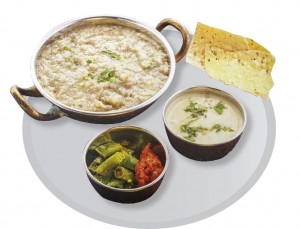
From the humble dal or cream of tomato soup to the exotic badam soup, this book has it all.
Those of us who have been told to put haldi (turmeric) in everything that we can, to ward off the evil coronavirus, can root for haldi milk. Who would have guessed that along with haldi, pepper powder and honey, you also have to put ghee into haldi milk? And that honey should never be added when the milk is very hot?
Learn from Parul’s book how to make delicious chutneys — be they coriander, lasun (garlic) or khajoor (date) and even the ever popular Gujarati snack — gathiya!
Those who travelled or attended Rotary events when Manoj Desai was RI director will be delighted to find a range of recipes for mouth-watering different kinds of khichdis. He would always root for any kind of khichdi!
Parul is particularly fond of the stuffed dhokli that her mother used to make; “she would stuff it with doodhi, and as it is best eaten fresh and hot” she would make it on Sundays. “But as my father was particularly fond of the potato, she would stuff it with potato too,” she laughs!
Who would have guessed that along with haldi, pepper powder and honey, you also have to put ghee into haldi milk?
The best thing about these recipes is that they are simple, easy and quick to make, and most of the ingredients required are normally available in an Indian kitchen.
The book is a veritable delight for vegetarians as it gives so many simple and tasty options. But, says Parul, even though she didn’t plan it that way “I now realise that Jains who are very strict about not eating onions, garlic etc can use many recipes from my book. This was brought home to me by a Punjabi friend who said that during Navratri they don’t consume onions and other roots, but as she had just bought a copy, she was able to make so many dishes from there which didn’t have onions, garlic, etc!”
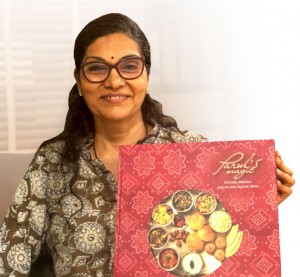
Printed on art paper, and with beautiful illustrations — most of the pictures she has taken at home on her iPhone — the book comes at a price of ₹3,000 ($50).
When I comment that the price might not be affordable to many people, she says that she is toying with the idea of coming out with a paperback, which will be priced modestly, in the near future.
The book costs ₹3,000 and can be ordered at www.parulsmagic.com.
Lapsi (Kansar)
Lapsi or Kansar is a traditional Gujarati sweet served as Prasad, or prepared during any auspicious occasion in the family. My aunt used to tell me that Kansar was one of the first sweet to be prepared in those days. This authentic sweet requires only four ingredients.
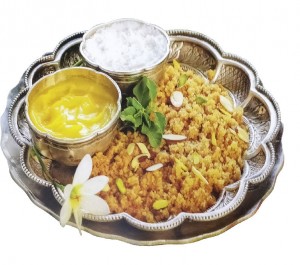
It is also customary to make Kansar on the wedding day in a Gujarati family.
Kansar Bhakshan ceremony: It is a first meal together for a couple immediately after the marriage. The bride’s mother brings Kansar on a plate and the couple feed each other to symbolise their union.
Ingredients
- 1 cup wheat flour coarse (like fine semolina)
- 2 tablespoons ghee for mixing
- 1 cup water
- ½ cup jaggery powder
- For serving
- 4 tablespoons ghee
- ¼ cup castor sugar / powder
Procedure
- Take wheat flour in bowl and add 2 tablespoons ghee and mix thoroughly with your hand.
- Take 1 cup of water in a heavy bottom pan or nonstick pan, add jaggery and boil it for 10 minutes or till jaggery melts. Remove from the heat and strain it with steel strainer to remove any impurities in the jaggery.
- Again boil jaggery water in heavy bottom pan, add wheat flour in boiling water and stir it thoroughly with wooden spoon or rolling pin. Make sure no lumps are there.
- Keep tawa / griddle under the pan and cover the pan with the lid. Cook for 10 minutes on low heat.
- Remove from the heat. Stir it with rolling pin and make sure there are no lumps.
- Add remaining ghee and mix thoroughly. Serve hot adding castor sugar.
- You can mix this with your hand and serve.
Note:
- Quantity of water depends on the quality of wheat flour.
- If you find Lapsi too dry sprinkle or add little more water at the time of mixing.
Thepla
Theplas are Gujaratis’ ever green comfort food and they can never get tired of eating.
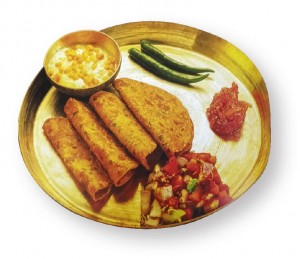
There are days when theplas find place at breakfast table with masala chai / Tea, in kids lunch box with chundo and as a dinner with plain dahi and batata nu rasaloo shaak (potato in gravy). Theplas are Gujaratis’ travel and picnic companion also.
Masala Thepla
Ingredients
- 2 cups wheat flour
- 2 tablespoons besan flour
- 4 teaspoons red chilli powder
- ¾ teaspoon turmeric powder
- 1 ¼ teaspoon salt
- 1 ¼ teaspoon cumin seeds
- 3 teaspoons sesame seeds
- 3 teaspoons amchur (dry mango powder)
- 2 tablespoons oil and 1 tablespoon ghee
- ¾ cup for kneading the dough
- Oil for shallow frying
Procedure
- Mix all ingredients in a broad bowl (except oil for shallow frying).
- Pour water little by little and knead a soft dough. Cover the dough with a wet muslin cloth and keep it aside for 20 minutes.
- Divide dough into equal size balls.
- Roll each into a thin circle (5” diameter).
- Heat tawa on a low flame. Once tawa is hot, place thepla on it and allow it to cook.
- When you see bubbles forming turn and cook other side. Put 1 teaspoon oil on thepla and press it with a ladle and cook till both sides turn brown. Remove from tawa and keep it on a plate.
- Repeat the same with remaining dough.
- Serve hot with chundo — sweet mango pickle or any other pickle or curds. Goes well with tea / coffee also.
Methi Thepla
To make methi thepla add 1 ½ cup fresh fenugreek leaves (picked, washed and finely chopped), ½ cup plain yogurt, 2 teaspoons green chilli paste and 2 teaspoons ginger garlic paste and knead a soft dough with yogurt, (add water if required). Follow the same procedure as above.
Tip:
- Can be stored at room temperature in an airtight container. Also handy when travelling.
- You can add little more oil while roasting on tawa.
